
Three Questions to Our Future Health Leaders in the Asian American Native Hawaiian Pacific Islander Community

When I interacted with the medical students, I remembered being in APAMSA, dreaming of making a positive impact in my Filipino community. Like the students, I did not fully know where to begin. The task of being a loud speaker for my AANHPI patients seemed daunting, especially since I did not see many doctors like me taking on this responsibility. The tunnel at the beginning of medical school training seemed endless, especially during 5AM morning pre-rounding. It seemed as though there was no end to the struggle. In the midst of test after test, rotation after rotation, and moments of sleep-deprived lunches in front of the computer’s electronic health record, I would ask myself "Am I actually making my patients healthier in front of this computer?"
Mentors around me, however, believed not only in my ability to complete training but also my ability to find purpose, to realize my dream of helping my patients and my community become healthier.
I want to let my APAMSA medical students know, firstly, that the most formative times in your medical training will be the times you spend outside of the classroom, sitting next to your patient, holding her hand in the hospital and giving her hope, or the time you are in the community in your patient's neighborhood, talking to his family members about health and happiness. Now, working in a clinician research fellowship, I take the daily opportunity to dive into AANHPI disparities research, realizing that there is indeed an ending to the tunnel of medical training. The light at the end of the tunnel actually exists!
Here are some tips I picked up over the last few years to help AANHPI medical students persevere in their training and engage with their community. Ask yourself these three questions:
1. Do I have a meaningful relationship with my mentor, a relationship I feel proud of?
Can you remember the last time you and your mentor set up a time to have a meaningful chat about your vision in becoming a future doctor? If you don’t remember, it's time to start writing that email, picking up that phone, and sending that text to that mentor! A strong mentor is her/his weight in gold and can easily help save you time and energy by helping bring direction to your career goals. These are the people that you envision becoming. They ideally can help bring clarity to the most confusing and stressful period of medical training while investing in your dreams and goals. They ideally will hold you accountable to your mission.
2. Are you engaged with your local AANHPI community?
I know that you all already have very busy schedules with seemingly endless hours of work along with tests. It is easy to lose sight of the forests for the trees. But try your best not to forget about the community, the neighborhood and setting where your patients spend most of their life. Though the days of home visits are largely lost (unless one works in concierge medicine), there are still ample opportunities to go to where your patient lives and explore what your patient goes through on the daily. On your off time, try to find ways to engage in community service. Be innovative! Walk around your patient’s neighborhood. Go to your patient’s local cultural festivals, eat at the restaurants where your patient may eat at, shop in the same places you patient frequents, and more. I can guarantee you that you will feel a deeper emotional connection to that patient and the community that you serve. Like a piece of coal, you do not want to be far away from the fire of your AANHPI community, lest you cool down and burn out.
3. Instead of keeping your eye on the prize, first ask yourself "What exactly is the prize?" Once you know the prize, you must envision yourself with the prize!
I feel that this is the most important thing that I can share with the medical students, especially those from the AANHPI background. We were often times placed in a position where becoming that surgeon or becoming that physician that Mom and Dad dreamed of was an inevitable career path in the midst of exceedingly high expectations. This is the time however that you want to ask yourself, “Why did I get into all of this in the first place? What is it that I truly want to achieve as a doctor and what is my prize?” Write it all down to concretize your thoughts. Only until you define your prize can you “keep your eye on the prize" as was often told to me during residency after every 3 day, 27 hour restless shift in the neurology ward. I believe that when a medical student can clearly define her prize and drive forward with grit toward that prize, it is nearly impossible to throw in the towel, to give up. Find incremental ways to break through the tunnel walls of medical training to let in some light. By the time you know it, you will be at the end of medical school, the end of residency, standing up and receiving your diplomas. It can be a reality!
The final message I have to share with the medical students is to keep APAMSA alive for the next generation because the pipeline does not end with you. Accumulate the knowledge you gain in this medical training process and please share your wisdom with the younger generation who looks up to you. Because if you don't advocate for your AANHPI students, patients, and community, then who else will?
